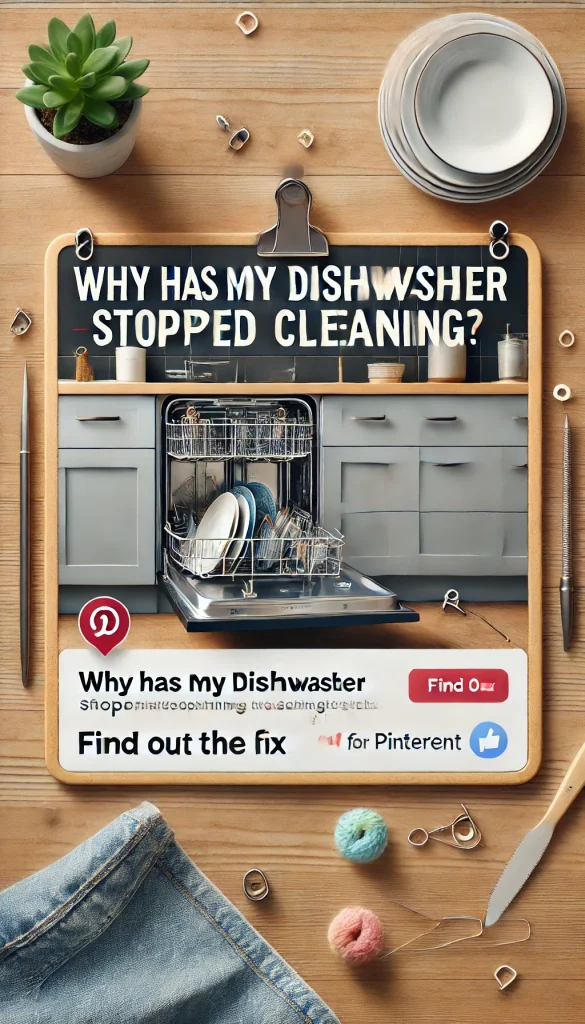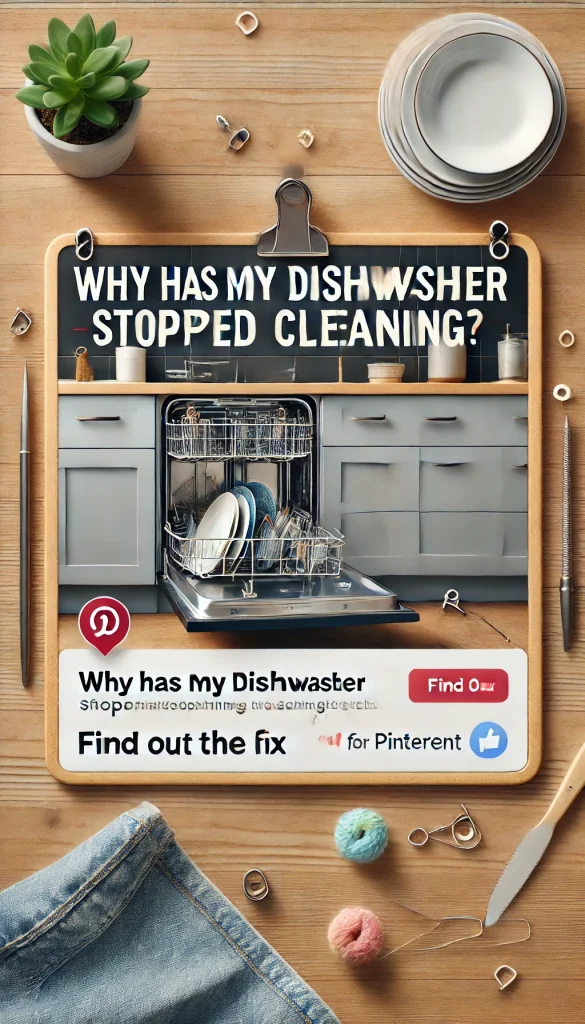You load your dishwasher, press start, and walk away with the comforting thought that your dishes will come out sparkling clean. But then, surprise! You open the door to find plates with food stuck on them and glasses that are anything but spotless. What gives? If your dishwasher has suddenly decided to go on strike, you’re not alone. Let’s dig into the common reasons why dishwashers stop cleaning and, more importantly, how to fix them. Ready? Let’s troubleshoot this together.

What Could Be Causing the Problem?
Alright, let’s tackle the big question: why isn’t your dishwasher cleaning anymore? Here are some usual suspects:
1. Clogged Spray Arms
- The spray arms are like the water guns of your dishwasher, blasting off grease and grime. But when they’re clogged with food particles or mineral buildup, the water flow gets blocked, and your dishes suffer.
2. Dirty Filter
- The filter’s job is to trap food particles and prevent them from recirculating. If it’s clogged, water can’t flow properly, leading to dirty dishes.
3. Improper Loading
- Overloading or placing items incorrectly can block the spray arms and prevent water from reaching all your dishes. Are you cramming everything in like it’s a game of dishwasher Tetris? That might be the issue.
4. Low Water Temperature
- Dishwashers rely on hot water to dissolve grease and activate detergent. If the water isn’t hot enough, your dishwasher can’t do its job effectively.
5. Hard Water Deposits
- Hard water can leave mineral deposits that block jets and create a film on your dishes. Over time, this buildup can affect your dishwasher’s performance.
6. Faulty Detergent Dispenser
- If the detergent dispenser doesn’t open properly during the cycle, your dishes won’t get clean.
Key takeaway: Most issues boil down to blockages, water temperature, or improper use. But don’t worry—these are often easy to fix.
Next: Let’s walk through the steps to get your dishwasher back in action.
Quick Fixes to Try First
Now that we know what might be causing the problem, let’s roll up our sleeves and fix it. Here are some simple solutions:
1. Clean the Spray Arms
- Remove the spray arms (check your manual if you’re unsure how).
- Use a toothpick or small brush to clear any blockages from the holes.
- Rinse them thoroughly under warm water and reinstall.
2. Check and Clean the Filter
- Locate the filter at the bottom of the dishwasher.
- Remove it and rinse it under warm water. Use a soft brush to scrub away stubborn debris.
- Reinstall the filter securely before running the dishwasher again.
3. Adjust Your Loading Technique
- Make sure dishes aren’t blocking the spray arms. Plates and bowls should face inward, and glasses should go on the top rack.
- Avoid overloading—leave enough space for water to circulate.
4. Test the Water Temperature
- Run your kitchen faucet until the water is hot before starting the dishwasher.
- For best results, the water temperature should be at least 120°F (49°C).
5. Run a Vinegar Cycle
- Place a cup of white vinegar in a dishwasher-safe bowl on the top rack.
- Run a hot water cycle to break down grease and remove any buildup.
Pro tip: If you suspect hard water is the issue, consider using a dishwasher cleaner or adding a rinse aid.
Next: What to do if these fixes don’t solve the problem.
When Basic Fixes Don’t Work
If you’ve tried the simple solutions and your dishwasher is still underperforming, it’s time to dig deeper:
1. Inspect the Detergent Dispenser
- Check if the dispenser is opening properly during the cycle. If it’s stuck or damaged, you may need to replace it.
2. Examine the Water Inlet Valve
- The water inlet valve controls how much water enters the dishwasher. If it’s clogged or faulty, your dishwasher might not be getting enough water.
3. Look at the Circulation Pump
- The pump is responsible for moving water through the spray arms. If it’s not working, the spray arms won’t function properly.
4. Check for Software Issues
- Some dishwashers have sensors or software that control cleaning cycles. A malfunction here could cause problems. Try resetting your dishwasher by turning off the power for a few minutes.
5. Call a Professional
- If you’ve exhausted all options, it might be time to call in an expert. Persistent issues like a broken pump or electrical faults require professional repair.
Next: Let’s wrap it up with some tips to prevent future problems.
Tips for Keeping Your Dishwasher Running Smoothly
Want to avoid this headache in the future? Follow these tips:
1. Clean Regularly:
- Deep clean your dishwasher once a month using vinegar and baking soda.
2. Use the Right Detergent:
- Stick to high-quality detergent and avoid using too much—it can leave behind residue.
3. Check the Spray Arms and Filter:
- Inspect these parts regularly to ensure they’re clean and functioning properly.
4. Run Hot Water:
- Always run your kitchen faucet until the water is hot before starting the dishwasher.
5. Avoid Overloading:
- Leave space for water and detergent to reach every dish.
Key takeaway: A little maintenance goes a long way in keeping your dishwasher working like new.
Conclusion: Get Your Dishwasher Back on Track
A dishwasher that stops cleaning is frustrating, but it’s often a fixable problem. Whether it’s a clogged spray arm, dirty filter, or low water temperature, a few simple steps can usually solve the issue. And with regular maintenance, you can keep your dishwasher running smoothly for years to come. Start with the quick fixes, and if the problem persists, don’t hesitate to dig a little deeper. Your sparkling clean dishes are just a cycle away!

